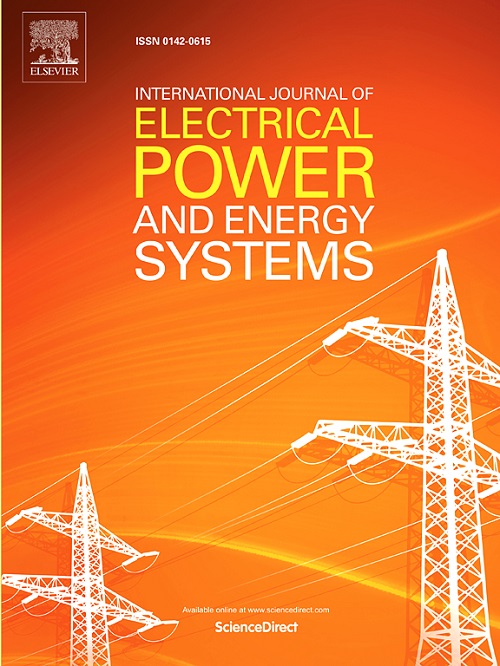基于设置组的1区最优到达自适应距离保护,以减轻网络状态变化的影响
IF 5
2区 工程技术
Q1 ENGINEERING, ELECTRICAL & ELECTRONIC
International Journal of Electrical Power & Energy Systems
Pub Date : 2025-08-29
DOI:10.1016/j.ijepes.2025.111061
引用次数: 0
摘要
距离继电器是传输网保护的重要组成部分,远程馈电等因素对保护系统的安全性和可靠性提出了挑战。为了解决这一问题,本文利用现有数值距离继电器的整定组(SG)能力,提出了一种基于预计算整定的自适应保护方法。该方案优化了继电器在R-X平面的zone-1覆盖范围,使其尽可能包括指定线路上的故障(可靠性),同时排除了指定线路外的故障(安全性)。本文考虑了不同拓扑(N-0、N-1和特定N-2拓扑)和故障前线路负载对继电器测量的视阻抗的影响。考虑到这些不同的拓扑结构和线路负载场景,网络状态(NST)的总数可能会大大大于可用的SGs数量,因此直接为每个NST分配一个不同的SG是不切实际的。这就需要对相似的NST进行分组,并为每个NST组分配一个SG。为了克服这一挑战,提出了一种混合粒子群优化-二进制整数线性规划(PSO-BILP)算法。该算法同时确定每个SG的最佳继电器设置,并确定在每个NST中激活的适当SG。PSO组件优化继电器的设置,而BILP组件为每个NST分配最佳SG。通过在IEEE 39总线网络上的实现和测试,证明了该方法的有效性,显示了保护系统性能的显着改善。本文章由计算机程序翻译,如有差异,请以英文原文为准。
Adaptive distance protection for zone-1 optimal reach to mitigate the impact of network state changes using setting groups
Distance relays are a crucial component of transmission network protection, and factors such as remote infeed make it challenging to ensure both security and dependability of the protection system. To address this challenge, this paper proposes an adaptive protection based on precalculated settings using the setting group (SG) capability of existing numerical distance relays. This scheme optimizes the zone-1 coverage of the relay in the R-X plane to include faults on the designated line as much as possible (dependability) while excluding faults outside the intended line (security). The paper considers the effects of different topologies (N-0, N-1, and specific N-2 topologies) and pre-fault line loads on the apparent impedance measured by the relay. Given these different topologies and line-loading scenarios, the total number of Network States (NSTs) can become significantly larger than the available number of SGs, making it impractical to assign a distinct SG to each NST directly. This necessitates mechanisms to group similar NSTs and assign an SG to each NST group. To overcome this challenge, a hybrid Particle Swarm Optimization-Binary Integer Linear Programming (PSO-BILP) algorithm is proposed. This algorithm simultaneously determines the optimum relay’s settings for each SG and identifies the proper SG to activate in each NST. The PSO component optimizes the relay’s settings, while the BILP component assigns the optimal SG for each NST. The effectiveness of this method is demonstrated through implementation and testing on the IEEE 39-bus network, showcasing significant improvements in the protection system’s performance.
求助全文
通过发布文献求助,成功后即可免费获取论文全文。
去求助
来源期刊
CiteScore
12.10
自引率
17.30%
发文量
1022
审稿时长
51 days
期刊介绍:
The journal covers theoretical developments in electrical power and energy systems and their applications. The coverage embraces: generation and network planning; reliability; long and short term operation; expert systems; neural networks; object oriented systems; system control centres; database and information systems; stock and parameter estimation; system security and adequacy; network theory, modelling and computation; small and large system dynamics; dynamic model identification; on-line control including load and switching control; protection; distribution systems; energy economics; impact of non-conventional systems; and man-machine interfaces.
As well as original research papers, the journal publishes short contributions, book reviews and conference reports. All papers are peer-reviewed by at least two referees.

 求助内容:
求助内容: 应助结果提醒方式:
应助结果提醒方式:


